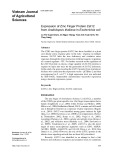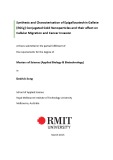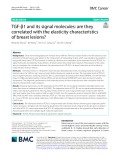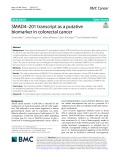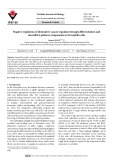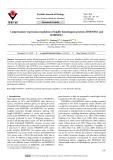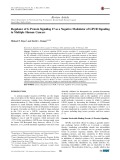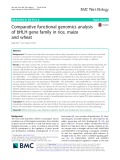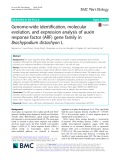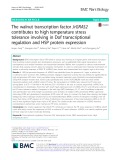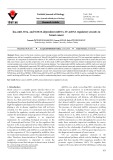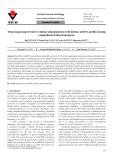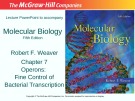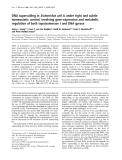
Expression regulation
-
The C2H2 zinc finger protein ZAT12 has been classified as a plant core abiotic stress response gene in the early response to multiple stresses. ZAT12 links the iron deficiency and oxidative stress responses through the direct interaction with/and negative regulation of a central regulator - FIT.
 8p
8p  vibecca
vibecca
 01-10-2024
01-10-2024
 3
3
 1
1
 Download
Download
-
Studies on nanoparticle-protein interaction have also not been studied. This would give information on ratio influence on the structural alteration of EGCg in EGCg-AuNPs and its functionality in vivo. Herein, the optimisation of EGCg-AuNPs will be determined with a large pool of stoichiometric synthesises of gold and EGCg. These optimised EGCg-AuNPs would then be studied with bovine serum albumin (BSA) for protein interactions, binding and thermodynamics.
 177p
177p  runthenight07
runthenight07
 01-03-2023
01-03-2023
 8
8
 3
3
 Download
Download
-
Shear wave elastography can evaluate tissue stiffness. Previous studies showed that the elasticity characteristics of breast lesions were related to the components of extracellular matrix which was regulated by transforming growth factor beta 1(TGF-β1) directly or indirectly.
 13p
13p  vielonmusk
vielonmusk
 21-01-2022
21-01-2022
 13
13
 1
1
 Download
Download
-
Transcripts with alternative 5′-untranslated regions (UTRs) result from the activity of alternative promoters and they can determine gene expression by influencing its stability and translational efficiency, thus executing complex regulation of developmental, physiological and pathological processes.
 9p
9p  vielonmusk
vielonmusk
 21-01-2022
21-01-2022
 11
11
 0
0
 Download
Download
-
RNA polymerase II (Pol II) is a 12 subunit protein complex from yeast to human that is required for gene expression. Gdown1 containing Pol II [Pol II (G)] is a special form of Pol II that is catalytically inactive and heavily depends on the 30-subunit Mediator complex for its activator and basal dependent function in vitro. Here we report for the first time, the identification and the generation of a 15-subunit human Mediator complex via the novel multibac baculovirus expression system that is fully responsive to Pol II (G).
 9p
9p  thiencuuchu
thiencuuchu
 27-11-2021
27-11-2021
 21
21
 3
3
 Download
Download
-
Drosophila model is intensively studied for the development of cancer. The diminutive (dMyc), a homolog of the human MYC gene, is responsible for cell- apoptosis and its upregulation is responsible for determining the fate of cancerous growth in humans and Drosophila model. This work implores the requirement of dMyc and its expression as one of the major regulator of cancer with other proteins and repression of dMyc mRNA in Drosophila S2 cells.
 7p
7p  thiencuuchu
thiencuuchu
 27-11-2021
27-11-2021
 16
16
 2
2
 Download
Download
-
Heterogeneous nuclear ribonucleoprotein (HNRNP) A1 and A2 are the most abundant HNRNPs with nearly identical functions, and play important roles in regulating gene expression at multiple levels (i.e. transcription, posttranscription, and translation). However, the expression and regulation mechanism of HNRNPA1 and A2 themselves remain unclear. In this study, the amino acid sequences of HNRNPA1 and HNRNPA2 were compared and found to have 78% and 86% homology in key functional domains.
 10p
10p  thiencuuchu
thiencuuchu
 27-11-2021
27-11-2021
 10
10
 1
1
 Download
Download
-
G-quadurplex (G4) formation plays a role in many biological processes such as replication, transcription, translation, and telomeric maintenance. Stabilization of G4 structure by peptide has recently emerged as a potential approach in the regulation of protein expression. In this study, we reported on regulation of cyan fluorescent protein (CFP) expression by the interaction of G4 and RNA helicase associated with AU-rich elements (RHAU) peptide in E. coli.
 7p
7p  larachdumlanat127
larachdumlanat127
 02-01-2021
02-01-2021
 6
6
 2
2
 Download
Download
-
Fibroblast growth factor-2 (FGF-2) is a multifunctional protein that plays an important role in the regulation of proliferation, differentiation and migration of a variety of cells. The recombinant human FGF-2 (rhFGF-2) is currently used in stem cell culture, medicine and cosmetic products. In this study, we aim to produce secreted rhFGF-2 protein from a Pichia pastoris strain containing multiple copies of the fgf-2 gene to eliminate the disadvantages of intracellular expression systems
 9p
9p  larachdumlanat127
larachdumlanat127
 02-01-2021
02-01-2021
 13
13
 2
2
 Download
Download
-
Nuclear factor erythroid-2 related factor 2 (Nrf2) is a crucial transcription factor that regulates the expression of defensive antioxidants and detoxification enzymes in cells. In a previous study, we showed that expression of the Nrf2 gene is regulated by an epigenetic modification. Rauvolfia verticillata, a traditional Chinese herbal medicine widely used in China, possesses anticancer and antioxidant effects. In this study, we investigated how Nrf2 is epigenetically regulated by reserpine, the main active component in R. verticillata, in mouse skin epidermal JB6 P+ cells.
 11p
11p  caothientrangnguyen
caothientrangnguyen
 09-05-2020
09-05-2020
 16
16
 2
2
 Download
Download
-
Regulators of G protein signaling (RGS) proteins modulate G protein-coupled receptor (GPCR) signaling networks by terminating signals produced by active Gα subunits. RGS17, a member of the RZ subfamily of RGS proteins, is typically only expressed in appreciable amounts in the human central nervous system, but previous works have shown that RGS17 expression is selectively upregulated in a number of malignancies, including lung, breast, prostate, and hepatocellular carcinoma.
 10p
10p  caothientrangnguyen
caothientrangnguyen
 09-05-2020
09-05-2020
 13
13
 1
1
 Download
Download
-
The basic helix-loop-helix transcription factors play important roles in diverse cellular and molecular processes. Comparative functional genomics can provide powerful approaches to draw inferences about gene function and evolution among species.
 21p
21p  vishikamaru2711
vishikamaru2711
 29-04-2020
29-04-2020
 15
15
 3
3
 Download
Download
-
The auxin response factor (ARF) gene family is involved in plant development and hormone regulation. Although the ARF gene family has been studied in some plant species, its structural features, molecular evolution, and expression profiling in Brachypodium distachyon L. are still not clear.
 15p
15p  vishikamaru2711
vishikamaru2711
 29-04-2020
29-04-2020
 31
31
 2
2
 Download
Download
-
GRAS transcription factor (TF) family is unique and numerous in higher plants with diverse functions that involving in plant growth and development processes, such as gibberellin (GA) signal transduction, root development, root nodule formation, and mycorrhiza formation.
 14p
14p  vishikamaru2711
vishikamaru2711
 29-04-2020
29-04-2020
 14
14
 2
2
 Download
Download
-
Breast cancer is the most common cancer among women and the molecular pathways that play main roles in breast cancer regulation are still not completely understood. MicroRNAs (miRNAs) and transcription factors (TFs) are important regulators of gene expression.
 17p
17p  nutifooddau
nutifooddau
 27-01-2019
27-01-2019
 13
13
 2
2
 Download
Download
-
MicroRNAs (miRNAs) are small noncoding RNAs of about 19–25 nt that regulate gene expression posttranscriptionally under various cellular conditions, including apoptosis. The miRNAs involved in modulation of apoptotic events in T cells are partially known.
 10p
10p  nutifooddau
nutifooddau
 27-01-2019
27-01-2019
 23
23
 2
2
 Download
Download
-
In chapter 7 we will explore one strategy bacteria employ to control the expression of their genes: by grouping functionally related genes together so they can be regulated together easily. Such a group of contiguous, coordinately controlled genes is called an operon.
 49p
49p  tangtuy05
tangtuy05
 30-03-2016
30-03-2016
 56
56
 2
2
 Download
Download
-
A novel vector platform for vitamin H-inducible transgene expression in mammalian cells have therefore designed a strategy to convert antibiotic-responsive transcription factors into gene regulation systems responsive to non-toxic biotin, also known as vitamin H.
 9p
9p  thuyancn
thuyancn
 01-06-2015
01-06-2015
 43
43
 5
5
 Download
Download
-
DNA of prokaryotes is in a nonequilibrium structural state, characterized as ÔactiveÕ DNA supercoiling. Alterations in this state aect many life processes and a homeostatic control of DNA supercoiling has been suggested [Menzel, R. & Gellert, M. (1983) Cell 34, 105±113]. We here report on a new method for quantifying homeostatic control of the high-energy state of in vivo DNA. The method involves making small perturbation in the expression of topoisomerase I, and measuring the eect on DNA supercoiling of a reporter plasmid and on the expression of DNA gyrase....
 8p
8p  system191
system191
 01-06-2013
01-06-2013
 34
34
 5
5
 Download
Download
-
The human b-globin gene locus is the subject of intense study, and over the past two decades a wealth of information has accumulated on how tissue-specific and stage-specific expression of its genes is achieved. The data are extensive and it would be difficult, if not impossible, to formulate a comprehensive model integrating every aspect of what is currently known. In this review, we introduce the fundamental characteristics of globin locus regulation as well as questions on which much of the current research is predicated.
 11p
11p  system191
system191
 01-06-2013
01-06-2013
 47
47
 4
4
 Download
Download
CHỦ ĐỀ BẠN MUỐN TÌM








